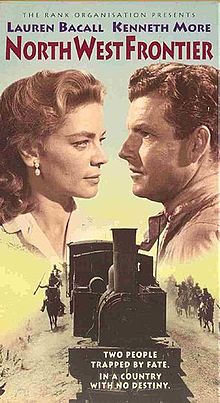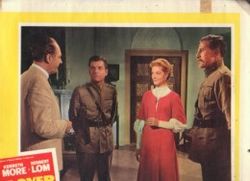- North West Frontier (film)
-
North West Frontier 
Theatrical posterDirected by J. Lee Thompson Produced by Marcel Hellman Written by Robin Estridge
Frank S. Nugent
Patrick Ford
Will PriceStarring Kenneth More
Lauren Bacall
Herbert Lom
Wilfrid Hyde-White
I. S. JoharMusic by Mischa Spoliansky Cinematography Geoffrey Unsworth Editing by Frederick Wilson Distributed by Rank Release date(s) 1959 Running time 129 min. Country U.K. Language English North West Frontier (retitled Flame Over India in the U.S. and Empress of India in Australia)[1] is a 1959 British adventure film starring Kenneth More and Lauren Bacall. The film was directed by J. Lee Thompson from a screenplay by Robin Estridge and also features Wilfrid Hyde-White, Herbert Lom and I. S. Johar.
The film is set in the North West Frontier Province of British India, which now lies within modern Pakistan. The film explores tensions between Hindu and Muslim Indians as Muslim rebels attack a fortress to kill a young Hindu maharajah.
The success of the film led to the American career of the director, who went on to make the Hollywood classic The Guns of Navarone in 1961, and it was also noted for Geoffrey Unsworth's cinematography.[2]
Contents
Plot
North West Frontier, British India, 1905: a Hindu maharajah asks British Army Captain Scott (Kenneth More) to take his son, Prince Kishan, to the safety of the Governor's Residence in Haserabad because a Muslim uprising has begun in his province. Accompanying them is a widow, Mrs Wyatt (Lauren Bacall), the prince's American nanny/governess. Soon after leaving, the rebels storm the palace and kill the maharajah.
On arrival at Haserabad, Captain Scott sees that the last trainful of local Hindus and Europeans are leaving on the last train to Kalapur. After it leaves, the rebels close in and take control of the outer wall and gate beside the railway yard. The British governor then tells Scott that he must take the young prince to Kalapur because it has become too dangerous to keep him in Haserabad. In the railyard, the British captain discovers the Empress of India, an old, obsolete engine lovingly cared for by its driver Gupta (I. S. Johar) and a battered old carriage.
In the early hours of the next morning, Captain Scott quietly loads the passengers on the train. They include Mrs Wyatt, Prince Kishan, arms dealer Mr Peters (Eugene Deckers), British ex-pat Mr Bridie (Wilfrid Hyde-White), Lady Wyndham (the governor's wife), two Indian NCOs and half-Dutch, half-Indian journalist Mr Van Layden (Herbert Lom). To avoid detection the Empress freewheels out of the yard, but unexpectedly the old engine lets off her whistle, alerting the rebels to the plan, so Gupta engages the steam to smash through the outer gate.
Later that morning, the train encounters the refugee train that had left the day before. It is found that everyone on board had been massacred by the rebels. But Mrs Wyatt, who rebuffs Captain Scott's order to remain on her train, finds one survivor; a small baby who was concealed by his mother's body. Later on that day, while stopping to refill the engine's tanks, Scott walks into the pump house to find Van Layden allowing Prince Kishan to stand dangerously close to the spinning flywheel. During the night, Mr Van Layden again approaches the prince only to notice Lady Wyndham staring at him.
The next morning, the train has to stop because part of the track has been blown up. However, they then realise that the rebels are already waiting for them in the surrounding mountains. The rebels' cover is blown when Mrs Wyatt spots a light shining at the mountain summit, which turns out to be a heliograph, the method of communication the rebels are using. With the job barely finished, the train gets away under a hail of gunfire. Gupta is hit in the arm but he survives. The train then reaches a large viaduct bridge which has been damaged by a bomb although the rails remain intact. All the passengers disembark and carefully cross the broken section. But again Van Layden's behaviour nearly results in the prince's death because he held him too short almost letting him fall. Captain Scott then carefully drives the train across the broken section. Once everybody is back on board, he accuses Van Layden of trying to kill the prince. The reporter is placed under arrest in the luggage compartment.
However going through a tunnel Van Layden uses the opportunity to overpower his guard. He then uses a Maxim machine gun to hold the passengers hostage. But he cannot kill Prince Kishnan immediately because he is riding on the engine outside. Eventually Scott returns to the carriage with the young prince, after spotting more heliograph signals used by the rebels, showing they've been waiting for them again, but they are saved as Van Layden is knocked off balance at the crucial moment. The British officer Scott pursues Van Layden onto the carriage roof. However it is Mrs Wyatt who shoots and kills Van Layden just as he is about to finish off Scott. The rebels catch up with the train on horseback, however they have to stop when it enters a two-mile-long tunnel. On the other side, the train and its passengers reach the safety of Kalapur. At the station Prince Kishan is met by senior Hindus, Gupta is taken to hospital, Lady Wyndham is informed her husband is safe because the rebels withdrew with the departure of the prince and Scott and Mrs Wyatt leave together.
Cast
- Kenneth More as Captain Scott
- Lauren Bacall as Catherine Wyatt
- Herbert Lom as Van Layden
- Wilfrid Hyde-White as Mr. Bridie
- I. S. Johar as Gupta, the driver
- Ursula Jeans as Lady Wyndham, the Governor's Wife
- Eugene Deckers as Mr. Peters
- Ian Hunter as Sir John Wyndham, the Governor
- Jack Gwillim as Brigadier Ames
- Govind Raja Ross as Prince Kishan
- Basil Hoskins as Aide-de-camp
- Moultrie Kelsall as British Correspondent
- Lionel Murton as American Correspondent
Awards
- BAFTA Awards
- 1960: Best Film: Nominated[3]
- 1960: Best Film from Any Source: J. Lee Thompson: Nominated[4]
- 1960: Best British Screenplay: Robin Estridge: Nominated[5]
Production notes
Exteriors were shot in southern Spain near Guadix, a city in the province of Granada, the dry arid steppe doubling for British India. The railway, now abandoned, traversed the northern part of the Sierra Nevada.[6]
The famous viaduct scene was filmed at Hacho Bridge which was completed in 1894 by engineers influenced by Gustav Eiffel. It is one of the largest bridges in Spain, 650 metres (2,130 ft) long and 50 metres (160 ft) high. The bridge is located between the two Andalusian cities of Guadahortuna and Alamedilla. Today the line across the viaduct has been lifted. A modern rail crossing has been built alongside the old iron bridge.[7][8]
Interiors were filmed at Pinewood Studios, London.
Public domain
The US-released version Flame Over India has lapsed into the public domain, and is regularly shown on American public television.
References
- ^ Review New York Times.
- ^ North West Frontier - Review Time Out, London.
- ^ Awards Internet Movie Database.
- ^ 1960 BAFTA Awards, winner & nominees Internet Movie Database.
- ^ Film Nominations 1959 British Academy of Film and Television Arts (BAFTA).
- ^ "OLD RAILWAY 2". Garingo.cool.ne.jp. http://garringo.cool.ne.jp/around%20guadix2-old%20railway2.htm. Retrieved 2009-07-02.
- ^ http://www.flickr.com/photos/telaraqua/3350576593/ Image of the bridge today
- ^ "Puente del Hacho, heart of iron". Official site for Tourism of the province of Granada. http://www.turgranada.es/excursiones-y-senderismo/excursiones-senderismo-detalle.php?id_idioma=2&id_seccion=360&tipo=secciones&seccion_ficha=354. Retrieved 2006-07-02.
External links
- Northwest Frontier at Rottentomatoes
- North West Frontier - Overview - Review at Channel 4.
- 'North West Frontier - Overview at British Film Institute
- North West Frontier at the Internet Movie Database
- North West Frontier at AllRovi
Categories:- 1959 films
- British films
- 1950s adventure films
- British Empire war films
- English-language films
- Films directed by J. Lee Thompson
- Films set in Pakistan
- Granada Province
- Films shot in Spain
- Andalusian culture
- Rail transport films
Wikimedia Foundation. 2010.

